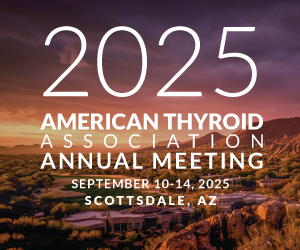
Thyroid Disruption and Triclosan in Consumer Products – Is the threat contained?
Ulla Feldt-Rasmussen, MD, DMSc
University of Copenhagen
Copenhagen, Denmark
October 18, 2021
Endocrine disruptors are chemical pollutants in the environment that can affect the action of endocrine glands, including the thyroid gland. Some are suspected to influence thyroid function negatively, while a direct causative relationship may not have been scientifically verified. This is especially the case with triclosan, a polychloro phenoxy phenol with hormonal disrupting properties and widespread use in toothpaste and cosmetic and household products.
To appreciate that an influence from triclosan can be detrimental to human health, it is important to understand the significance of intact thyroid function, and how triclosan may impair it. The thyroid gland produces primarily thyroxine (T4), which is paramount for metabolism in every single cell and organ by conversion to the metabolically active triiodothyronine (T3). T4 is thus essential for maintenance of optimal organ function, including the brain, heart, bones, and muscles, and it is vital to fetal neurological and cognitive development.
Triclosan is structurally similar to T4, and it is therefore possible that it can interfere with the function of T4 at one or more sites of the thyroid function pathways. Triclosan may potentially result in hypothyroidism in the person who has been directly exposed to it, but it can also potentially indirectly compromise neurodevelopment through placental transfer to the fetus.
So, why is triclosan problematic for human health? Triclosan is a broad spectrum antimicrobial used as an antiseptic, disinfectant or preservative in clinical settings and various consumer products including cosmetics, household cleaning products, plastic materials, toys, paints, etc. It was detected in the urine of 97% of young Danish men in 2013, with a decreasing tendency over 8 years, consistent with Denmark’s restriction of the use of triclosan before the official recommendations. Results from The National Health and Nutrition Examination Survey (NHANES) of a nationally annual representative sample of about 5,000 persons from different places within the USA also demonstrated declined concentrations of triclosan, but the NHANESIII 2019 study measured concentrations three to ten times higher in young Americans compared to young Danes.
Both the FDA and the EU introduced regulations with triclosan limits up to 0.3% due to suspicion of skin reactions, cancer development and hormonal disruption in both humans and animals, but it is unknown if these regulations suffice as thyroid protection. It is also unknown if people living in relative iodine deficient areas and people, mainly women, with a low thyroid reserve such as thyroid autoimmunity are more prone to the negative influence on thyroid function.
It is largely unknown if the rest of the world complies with the levels in FDA and EU regulations, but in China and Vietnam for example, triclosan is measured at very high levels in household dust. This is possibly due to slow leakage from its incorporation onto surfaces of medical devices, plastic materials, textiles, kitchen utensils, etc., intended for a long period of biocidal effect in these household products.
The global threat from triclosan as a thyroid disrupter is therefore not solved. As a traveler or online shopper importing potentially affected products, it is therefore important to bear this in mind. It remains necessary to explore the effects of triclosan in human thyroid health in more detail by both clinical and basic research.
References:
1. https://www.thyroid.org/patient-thyroid-information/ct-for-patients/march-2020/vol-13-issue-3-p-11-12/
2. https://ec.europa.eu/health/scientific_committees/opinions_layman/triclosan/en/l-3/2-uses-cosmetics-disinfectant.htm
Disclaimer:
The ideas and opinions expressed on the ATA Blogs do not necessarily reflect those of the ATA. None of the information posted is intended as medical, legal, or business advice, or advice about reimbursement for health care services. The mention of any product, service, company, therapy or physician practice does not constitute an endorsement of any kind by ATA. ATA assumes no responsibility for any injury or damage to persons or property arising out of or related to any use of the material contained in, posted on, or linked to this site, or any errors or omissions.
For more information on Thyroid Topics please visit: https://www.thyroid.org/thyroid-information/



